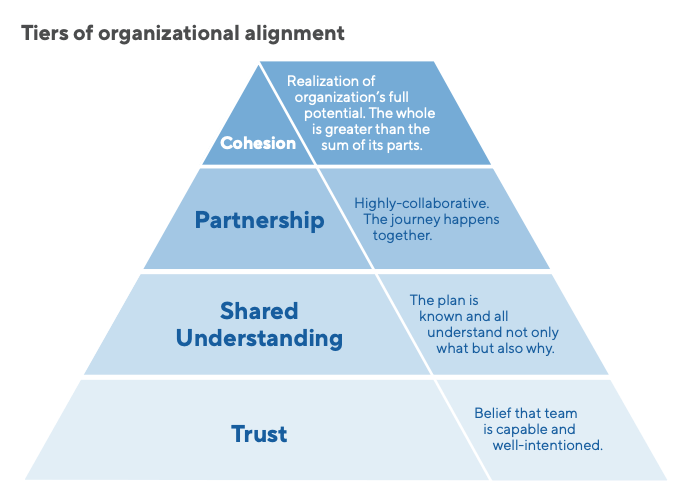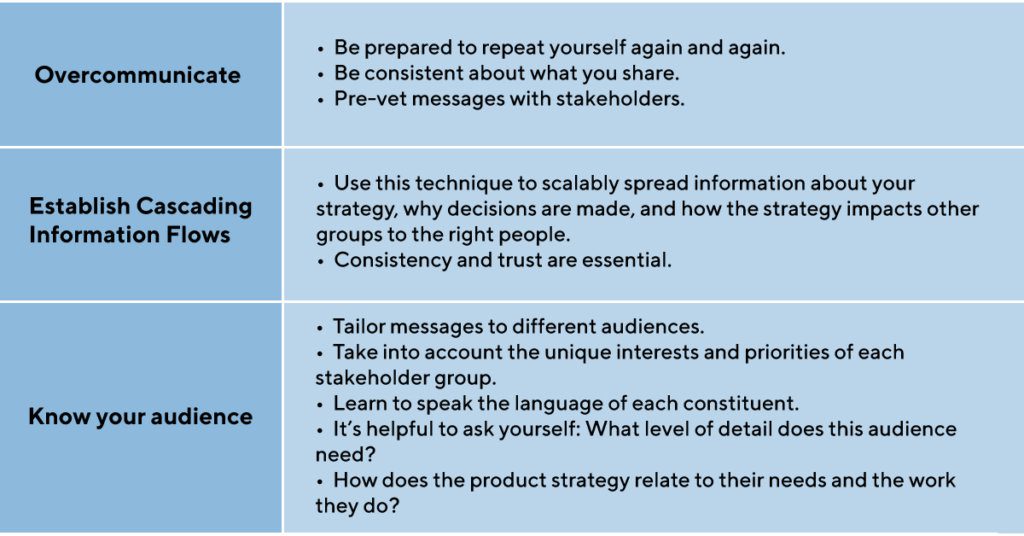As organizations grow and expand, keeping stakeholders and employees on the same page to drive alignment with your product strategy can be a big challenge. That’s because growth often brings culture shifts, new offices in different locations, and new hires with the different product vision. All of these changes tend to cause a few disruptions.
Without intentional action to maintain cohesion and alignment, silos can emerge, isolating teams and departments from each other and the company. It’s up to the product leader and product team to unite everyone around the product strategy.
“The only constant you see throughout the growth of a company is the need to align strategy and vision throughout all of the groups, as product managers, we need to make it part of our core goal. We need to be the glue that holds this together.”
—Daniel Elizalde, Product Management Coach
Driving true alignment around product strategy requires much more than hosting a quarterly company-wide product roadmap presentation. It means embedding a mindset of transparency, communication, and partnership into every step of the product development process.
In this post, we’ll explore five strategies for driving alignment across your team to operate with an “us” mentality.
5 Strategies for Driving Alignment
1. Start with Solid Communication
A key responsibility of a product manager is transmitting the right information to the right people in the right way and at the right time.
Product managers are more than gatekeepers of information or sources of continuous status updates. They must drive enthusiasm around product strategy and align the entire organization around the product vision. They need to be the glue that connects and unites the organization around a common goal.
“Someone has to be the hub for cross-organizational communication, and I think product management is well placed to do that because we understand the business, understand the customer, and understand the constraints and capabilities of engineering. And if we’re doing our jobs, we should also understand what all this means to the other functions.”
—Scott Williamson, VP of Product Management at GitLab
True alignment goes far deeper than strategy. Successful product leaders also work to demonstrate the value of product management to their organizations consistently. They burn down silos by helping their teams build bridges and establish cross-functional partnerships. They seek to make cohesion a way of life.
It’s why communication is just the beginning of the journey. When we talk about driving this deeply embedded system of organizational alignment, we’re talking about so much more than broadcasting the strategy. Watch our webinar for rethinking communication strategies:
2. Build a Foundation of Trust
The product team’s relationship with the rest of the organization is built on a carefully constructed foundation of trust. The product team needs others within the organization to trust their ability to make solid directions and lead the product in the right direction.
While you can’t rush the trust-building process, you can get a solid start by giving the organization visibility into your team’s success and learning.
Next, be transparent about your team’s decision-making process. Let individuals in your organization know what the plan is, and why. This knowledge is power, and empowering your organization with the why behind the plan is an essential step in building trust.
Remember, too, that cultivating meaningful connections with others goes a long way in breaking down barriers and strengthening relationships. Building trust takes time and intention. (If you need an icebreaker to get a casual conversation going, try this.)

3. Promote Shared Understanding
A sense of shared understanding occurs when the entire organization knows what the plan is and why. As well as, how the strategy ties back to the work they’re doing.
Accomplishing this requires a strategic (and agile) communication approach that includes communicating more than you think you need to, being consistent about what you share, and carefully tailoring messages to different audiences.

Promoting shared understanding is an ongoing effort. Plans change, priorities shift, competitors appear, and markets evolve. Successful product teams should seek ways to provide access to updated plans and context in real-time.
4. Establish Cross-Functional Partnerships
As organizations scale, silos often follow. If your alignment strategy doesn’t evolve as the organization grows, your team’s reputation and relationships can suffer. That’s why it’s essential to evolve your approach to ensure that the company sees the product team as a trusted partner.
Your product can’t reach its potential if you fail to tap into the collective knowledge and experience of the other teams in your organization. Healthy cross-functional partnerships help product teams reap the full benefits of working closely with all of the other teams.
With trust and shared understanding already in place, establishing healthy, balanced, cross-functional partnerships should be fairly straightforward if you keep your team aligned on what type of partners they should be: outcome optimizers. When the product team leverages their partnerships to optimize outcomes, everyone wins.
The product team gets valuable insight and observations from throughout the organization. Effective product managers are looped in on customer needs and are included in customer visits and calls scheduled by other teams. Other groups within the organization feel empowered to share what they’re seeing and hearing with the product team because they’ve learned what types of feedback matter to the product team. They know you hear them and are factoring in their input. As a result of this collaboration, customer needs and business objectives are better served by what you’re building.

Here are three ways to operationalize cross-functional partnerships:
1. Use the Buddy System:
Pair up individual product managers with other functional teams. For example, one product manager on your team can own the relationship between product development and customer success, while another product manager is the point person for the sales team.
2. Leverage Organizational Structures:
Have the whole product team meet regularly with the heads of each department to discuss what they’ve seen and heard recently.
3. Consider Communication Tools:
If your team uses Slack, consider creating a dedicated channel for sharing feedback. Or, give your team access to an “ideas” backlog where they can contribute their ideas as they come up.
5. Reach for Cohesion
Product organizations that reach a level of cohesion can fully realize their full potential and work together effectively. They’ve forged connections, developed cross-functional partnerships, and united the organization toward a common goal. They’ve learned how to make organizational alignment (and the trust, shared understanding, and partnership that fosters it) a part of everyday culture.
Keep in mind that cohesion requires consistency—in the way you’re making decisions, methods used to communicate those decisions, the quality of information shared, and meeting expectations.
Product leaders need to hold both themselves and the product team accountable for maintaining both consistency and transparency. It doesn’t always mean operationalizing these things or implementing heavy-weight processes, but setting standards and sticking to them.
Takeaways: Driving Alignment Around the Strategy
Burning down silos and building bridges in their place requires intentional action and a flexible mindset. Use these five strategies to drive alignment across your team to operate with an “us” mentality.





